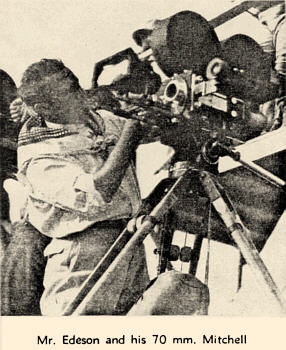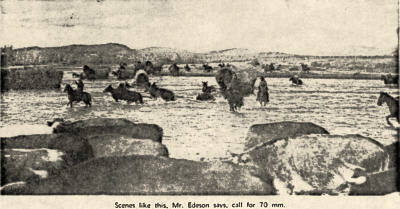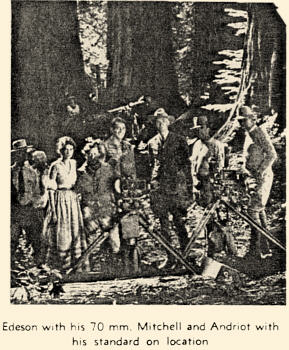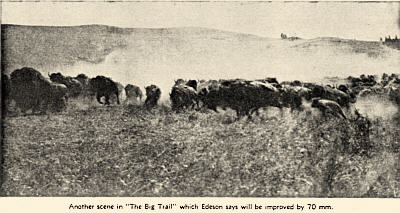Wide Film Cinematography By ARTHUR EDESON, A.S.C. IF ANYONE had, a few months ago, told me that I would not only be photographing a big picture on wide film, but also rabidly enthusiastic over its artistic possibilities, I would have thought him crazy. For I had the typical, conservative cameraman's attitude toward wide film: it might be all right as a novelty, but as a practical medium for serious artistic work it was impossible. I could think of too many technical and artistic flaws in it to ever think that it could gain a cameraman's favor. Everything-especially the new proportion of its picture-seemed absolutely wrong. Since then, I have spent more than six months photographing the 70 millimeter version of Raoul Walsh's "The Big Trail." In this time I have shot hundreds of thousands of feet of Grandeur film, and the results have convinced me that I, and not the process, was wrong. And now that the production is completed, I know that I shall find it difficult, indeed, to return to the cramped proportions of our present-day standard film. For 70 millimeter photography has given me an entirely new perspective. Instead of regarding things in the light of the old, cramped, Movietone frame, I now see them, photographically, as my eye naturally perceives them-in much the same proportions as the low, wide Grandeur frame. Technically, 70 millimeter cinematography is much the same as ordinary 35 mm cinematography. The cameras are standard Mitchell cameras. The film is standard Eastman Type Two Panchromatic. The lenses are, in most respects, similar to standard lenses. It is in the lenses, however, that the chief technical difference is found, for any given lens will embrace a considerably wider angle of view on the 70 mm. film than on the smaller standard. Therefore, when, as in this present picture, two versions are to be shot, the 70 millimeter camera must use a lens of approximately double the focal length of the lens used to make a corresponding 35 mm. shot. Or, reversing the example, when the cameraman uses a lens of a given focal length, the standard cameraman must use a lens of approximately half that size to make his corresponding shot. The shortest focal-length lens that I used during the making of "The Big Trail" was 50 mm., although 40 mm. is claimed to be theoretically the absolute minimum useable. However, as this was actual production work, and not laboratory tests. I preferred to play safe, and never used anything below a fifty When I used a fifty on a shot, the standard cameraman would use a twenty-five to produce a corresponding shot on his smaller film; when his shot required a fifty, mine would demand a four inch, and so on In this picture, though the majority of the scenes were duplicated shot for shot, in each size of film ,as nearly as was possible, the Grandeur version, being considered the most important, received the greater attention. So it was the requirements of the 70 millimeter cameras that dictated the lenses to be used, the set-ups, action, and all such matters.
The selection of lenses for 70 millimeter use is especially important. One of the chief photographic complaints against wide-film has been that there was only too often a marked falling off in definition at the extremities of the picture. The only cure for this is the use of lenses of the very highest quality-the very best of the best. Of course, any cameraman worthy of the name will take great pains in the selection of his lens equipment, but in selecting wide-film objectives, he must take even more extraordinary precautions. This naturally means an endless amount of testing before even one lens is chosen, but it is well worth it, for only the best lenses can give perfect Grandeur pictures, and only perfect pictures can reveal the full possibilities of 70 millimeter. In my own case, when I was assigned to the 70 millimeter camerawork on "The Big Trail," I realized the importance of proper lens equipment, and spent a long time seeking the very finest lenses available-and saw to it that my associates on the picture did likewise. When I had finally decided on the particular make of lens that I wanted to use, I had the manufacturers supply me with an extremely large assortment of lenses of every size from which to choose. These I tested in every conceivable manner, visually and photographically; I found that the only true indication of their capabilities was their performance in actual photographic tests. And even though the lenses I used were the product of what is probably the most efficient and exacting optical firm in the world, I found that I had to test at least ten or a dozen individual lenses to obtain one which met all of my tests perfectly. But this trouble and expense was not only amply justified in the quality of the photography which resulted when the picture went into production, but in the fact that I now have as perfect a lens equipment for either 70 mm. or 35 mm. cinematography as has ever been assembled. For these lenses may be used interchangeably on either my 70 mm. Mitchell, or upon my regular 35 mm. Mitchell camera. The chief requirements for lenses for wide-film cinematography are, first and foremost, extremely wide covering power; and secondly (and of quite as great importance), extremely great depth of focus. Due to the more natural shape of the Grandeur frame, there is a certain pseudo-stereoscopic effect produced: but this effect is lost unless there is a very considerable depth of focus in the image. The 70 millimeter picture is very nearly the same proportion as the natural field of our vision, which, I suppose, is responsible for this pseudostereoscopy. But, clearly, to take full advantage of this, we must use lenses which will give us a degree of depth at least somewhat approximating that of our eyes. Therefore, it is vital that Grandeur lenses be selected with a view toward getting this effect, so that the crispest, deepest pictures may be had Another point which has been a source of trouble to the early users of wide film is its liability to abrasion. During the many months we were working on "The Big Trail," we shot more than half a million feet of 70 mm. alone, with absolute freedom from scratches or abrasions of any kind. This was done merely by exercising extreme care in the always important matter of keeping the cameras and magazines clean. It became a hard and fast rule that the cameras must be cleaned thoroughly every night, not only with brushes, but with compressed air streams. And, since we were working under all sorts of conditions on the various locations which we pioneered-in the insufferable heat, humidity, and dust of the Arizona deserts; the damp cold of the Montana and Wyoming mountains; and the dank dustiness of the northern forests-without any trouble from this source, it would seem that only such care is necessary as a preventive
Another troublesome detail for which we found care a sure cure is that of film curling and buckling. A buckle in a 70 millimeter camera is a terrible thing, for it not only ruins a large quantity of valuable film, and often damages the camera, but it invariably makes the motor a total loss. During our first week's work on the picture, we had several bad buckles-which meant new motors every time. Naturally this was serious; it couldn't be allowed to continue. So we bent all our energies toward finding the cause of these buckles. Eventually we found it to be caused by friction between the edges of the film and the walls of the magazines. After that, we took special pains in loading, making sure that every roll of film used was absolutely true to its spool, with no chance of touching the walls of the magazine-and we had no more buckles during the picture. Aside from these details, Grandeur cinematography is, from the technical viewpoint, no different from standard-size camerawork. Any man who is technically able to do good work on 35 mm. film should therefore be able to do just as well on wide film. In this connection, it is interesting to note that while on "The Big Trail," as we were constantly moving around the country during our extended location trip, neither Mr. Walsh nor myself was able to see any of the film which we shot until our return to Hollywood-nearly five months later That the film-more than 500,000 feet of Grandeur alone-was all technically perfect is not only a definite demonstration that wide-film cinematography is basically the same as 35 mm work, but a very high tribute to my associates who manned the other Grandeur cameras. From the artistic viewpoint, the chief requirement of Grandeur cinematography is that both the cameraman and the director learn to accommodate themselves to the wider frame. The cameraman's problem is probably the easier, for he soon learns that composing a picture on the wide frame of the Grandeur camera is not, essentially, so different from composing for the old "silent standard" rectangle, and far easier than for the nearly square Movietone frame. If a man is enough of an artist to successfully compose his cinematic pictures for the earlier formats, he should be able to accommodate himself to this new one, just as a good painter can adapt himself to the requirements of his usual canvas, or of great mural panels. The director, however, must in a Grandeur picture pay considerably more attention to his background action than is usually the case, for, even in close-ups, the depth of focus demanded by Grandeur makes the background an important part of the picture. Incidentally, Grandeur reduces the number of close-ups considerably, as the figures are so much larger that semi-close-ups are usually all that is needed.
In working on such a picture as "The Big Trail," 70 millimeter is a tremendously important aid for the epic sweep of the picture demands that it be painted against a great canvas. Grandeur gives us such a canvas to work with, and enables us to make the background play its part in the picture, just as it did in the historical events which we are dramatizing. And that is what we have tried to do throughout this picture: to make history live again upon the screen. The chief motif of the story is the indomitable perseverance of the pioneers, as shown in their pushing west across the great deserts, the vast plains, the towering mountains, and into the great forests of California and Oregon. The background thus plays a vitally important role in the picture-a role which can only be brought out completely by being shown as 70 millimeter film can show it. Lucien Andriot, who photographed the standard-film version of the picture, did a superb piece of work, but the medium with which he was working could not begin to capture the vast sweep of the story and its background as did the Grandeur. Working in 35 mm. film, he was simply unable to dramatize the backgrounds as did the larger film, for in 35 mm. he could not attempt to adequately show both the vast backgrounds and the intimate foreground action in a single shot as the Grandeur cameras can. The illustrations reproducing the identical scene as treated by both 35 mm. and Grandeur cameras shows this admirably. From my experience with 70 millimeter cinematography on "The Big Trail," I can confidently say that the wider film s not only the coming medium for such great pictures, but that it will undoubtedly become the favored one for all types of picture. It marks a definite advance in motion picture technique, and from it will undoubtedly be evolved the truly stereoscopic picture of the future, toward which so many people have long been striving. As I have worked, so far, only with the 70 mm. film, I hardly feel qualified to prophesy as to the width which the industry will ultimately adopt as the standard, although I naturally lean toward the Grandeur, with which I am most accustomed. However, wider film is so definitely a desirable improvement that I hope that a definite standard will soon be accepted. Once that standard has been determined, the public will, if given suitable pictures on the wider film, undoubtedly show a decided preference for it. None the less, 35 mm. versions must continue to be made for a long time: but this will not be overly difficult, as reductions can be made from Grandeur negatives with perfect satisfaction, by optical printing, and at a far less expense than by shooting two versions, as has been done on all the wide-film pictures thus far made. This will, of course, impose upon the cameraman and director a necessity for unusually great care in making his composition: but it will hardly be more difficult than his present problem of composing 35 mm pictures so that they will be suitable for all of the many projection apertures in use throughout the world. The greatest difficulty here will be in composing his two-shots, which will have to be made so that they can be, in the reduction-print, made into two separate close-ups. But this difficulty is only a minor one when compared with the very great advantages which 70 millimeter cinematography offers in all other respects. And when these advantages, and those which the wide film soundtrack offers the sound-engineers, are combined with a perfected system of color cinematography, cinematographers and directors will indeed have a medium which is worthy of their best artistic and technical efforts.
From a Practical Cinematographer




HTML Transcription ©1998 THE AMERICAN WIDESCREEN MUSEUM